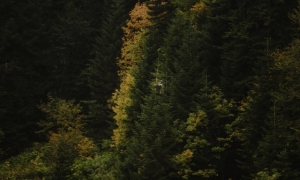The Guardian: Georgian Harvesters Risking Lives to Supply EU with Xmas Trees
In Georgia’s northern region of Racha, where the mountainous forests reach all the way up to the Caucasus peaks and the alpine zone, there is an abundance of pinecones which are harvested for their seeds, then exported Europe-wide to produce Nordmann Fir trees for Christmas.
"But while foreign importers line their pockets, the climbers hazard all for a pittance," The Guardian's journalist Jenny Gustafsson claims in an article released today.
“I try to not think of anything up there, just focus. The problem is, if you lose concentration, then you might fall,” one of the local Georgian harvesters says.
This gathering happens in Ambrolauri, seeing the forest filling with locals, fewer every year as the young move to find income in the cities, all in search of the same thing: pine cones or, more specifically, the seeds concealed inside. These seeds, once transported and planted in European soil, will harvest Europe’s desired Christmas trees, the tall and gracious looking Nordmann fir.
“It is thick and green with a beautiful shape. And most importantly, it doesn’t drop its needles,” says Marianne Bols, a Danish tree grower.
She is among a number of importers who come to the forest every year to bring seeds back to Europe. The industry is immense: about 150 million Christmas trees are sold annually on the continent. It is exceptional that a third of them, perhaps more, originate from the Ambrolauri region.
The Guardian notes that the Georgian cone pickers, who come from small towns and villages near the forest and risk their lives gathering the cones, “see little of the final earnings”.
“I was practically born in the forest, and have been climbing since I was a kid,” says Lasha Sopromadze, from the village of Tlugi at the forest’s edge. Each season Sopromadze earns between 1,000 and 2,000 GEL (£262 and £524). The price per kilo varies from year to year, from one to two GEL, a small fraction of the price for a full-grown tree in Europe.
Gustafsson speaks to Lamara Katsitadze-Jikhvashvili, 77, who spent her youth climbing the firs for cones.
“Everyone would do it. The entire village went into the woods in autumn. We would cook together in the evenings, and the food tasted like the sap on our fingers,” Katsitadze-Jikhvashvili tells The Guardian journalist. “Climbing is not difficult. We just grabbed the branches one by one. Once up, we would swing and jump from tree to tree.”
These days ropes and hard-hats are brought by the companies to protect the climbers in their service, though not all climbers wear them.
“It’s much faster to climb without- you can finish a tree in 20 minutes. Otherwise you need an hour,” Sopromadze tells Gustafsson.
Several people have died, most recently in 2001 and 2011. The 1990s brought two tragic deaths: a 16-year-old boy and 26-year-old Gaga Namgaladze, whose brother later became the mayor of Ambrolauri, The Guardian reports.
"Companies say that they enforce strong safety measures now," Gustafsson writes. "Bols’ company, Fair Trees, holds annual safety trainings with their climbers; Levinsen & Abies brought new ropes and harnesses this year. Fair Trees also runs several social projects, including a free dental clinic and breast cancer check-ups. They pay their climbers significantly more than others, too: five lari per kilo of cones. But the industry’s wealth has yet to transform into real improvement for people in Ambrolauri. The municipality taxes every kilo of cones at an equivalent of 15p. But no one controls how much is harvested."
Read the full article here.
By B.Alexishvili












